13
2017
What your nonprofit can learn from for-profit businesses

If your not-for-profit is “stuck” and you’re not sure how to move forward, consider adopting some for-profit business practices. The essential missions of businesses and nonprofits are different, but the ways to achieve them often are the same.
Make a plan
The strategic plan — a map of near- and long-term goals and how to reach them — lies at the core of most for-profit companies. If your nonprofit doesn’t have a strategic plan or has been lax about revising an existing one,









 Even though most tax-exempt organizations do not pay federal taxes, most of them have to file an annual information return, which is called a Form 990.
Even though most tax-exempt organizations do not pay federal taxes, most of them have to file an annual information return, which is called a Form 990. h the term from the IRS. Let’s be honest, none of us “want” to be audited. However, it’s not always a bad thing.
h the term from the IRS. Let’s be honest, none of us “want” to be audited. However, it’s not always a bad thing.

